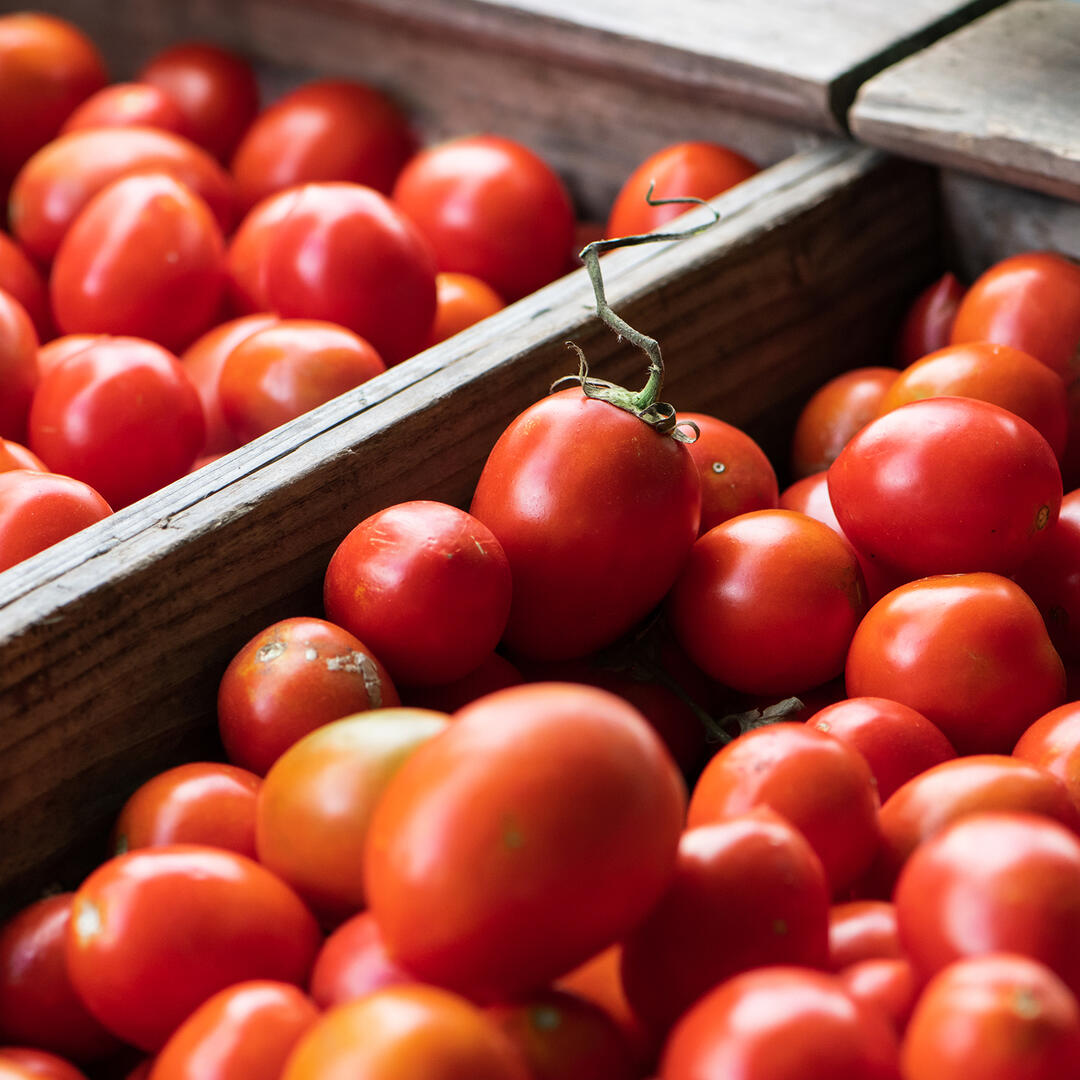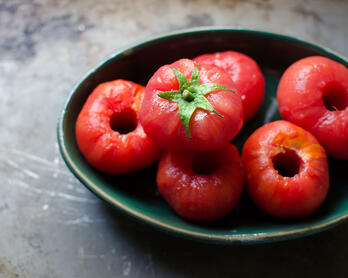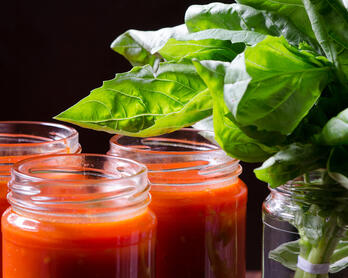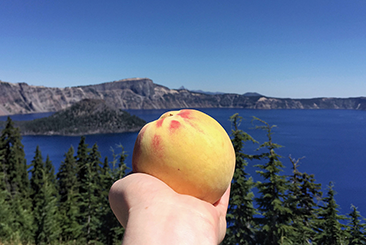Tomato Salt

RECIPE UPDATED 7/26/23
Summer tomatoes and peppers are piled high at the farmers market which means I'm in ongoing negotiations with my freezer for space. Tomatillos and mangoes already occupy a considerable amount of real estate and the queue of roasted jalapeños, sweet bells, and tomatoes is growing.
Gjelina’s Pomodoro Sauce is always on the agenda and a recent batch found me staring into a food mill filled with a tangle of tomato skins. The peak season smell and vibrant color got me thinking about how I could give those umami scraps a second life. A quick search brought up tomato powder which led me to this recipe for tomato salt. Say no more. The only real step is drying the skins and as mentioned in the Vegetarian Fish Sauce post, dried tomatoes have 3x the glutamate as fresh giving them extra umami. You can't go wrong making a flavored salt out of the stuff.
If you want to take an even simpler route, freeze the undried skins to use for stock. Both my Roasted Vegetable Stock and Roasted Chicken Stock call for tomatoes so I saved some skins in the freezer to use at a later date. Any strained broth that a tomato might compliment could be an opportunity to use the frozen skins. Never underestimate the power of subtle layers.
Tomato salt turned out to be a minimal effort project that adds a solid building block to the pantry. It smells sweet and savory but the flavor isn't overpowering which makes it an easy swap with regular salt. I sprinkle it over eggs, sauces, garlic bread, burgers, and anything with avocado. The bonus is that tomato salt reduces waste so pat yourself on the back for saving some trash and add it to all the things.

Tomatoes in my Rösle food mill.
Tomato Skin Use - Honorable Mention
For grins, I puréed a handful of tomato skins with water and then strained the mixture. The liquid has a tomato-ey flavor and certainly tastes like something more than H2O so I added it to the crowded freezer for an unknown use - maybe sauteed vegetables or thinning a sauce. I'm not sure that I would go out of my way to make this again but it was fun to try. I made a "real" version of tomato water to use in bread so that will probably be a different post.
Farmers| Artisans
I make an effort to source my food from California artisans with a special focus on the Santa Monica Farmers Market. Below is a list of the folks who contributed to this dish.
- Finley Farms // Tomatoes
- Coleman Family Farms // Tomatoes
- Weiser Family Farms // Tomatoes
- Underwood Family Farms // Tomatoes
- Munak Ranch // Tomatoes

Tools
- Dehydrator (optional - see Instructions below) - For years, I resisted buying one because I didn't think it would get much use. 'Twas the great cherry season of 2019 - in the before times - that finally convinced me otherwise. Not only is the dehydrator light and easy to store up in a closet, but new uses regularly pop into my head. It does a beautiful job with tomato skins and I've dried raspberries (best friends with spelt flour), tomatoes, herbs, Thai chiles, cherries, mangoes, and more.
- Scale - There are two scales in my kitchen, the workhorse being my OXO model. It's a sturdy cooking companion that repeatedly gets covered in flour, sauce, or whatever else is flying around the kitchen. I recommend keeping liquids away from the screen since they can find their way inside. That being said, the scale seems to dry out and keep on measuring. Note: My original scale with the black pull-out display is now made in all stainless steel. Watch out for the online sellers who are price-gouging and charging $75 for the older model. As far as I can tell, the new all stainless version is the same.
- Spice Grinder - Grinding whole spices offers a big flavor payoff for relatively little effort. This grinder gets the job done and is easy to clean and store. Similar to the dehydrator, I use it more than expected.
Ingredients
- Tomato skins - Step 4 of making Gjelina's Pomodoro Sauce involves processing the tomatoes through a food mill. Those skins are what I scoop out and dry for the tomato salt. You could also make Gjelina's Tomato Confit and use the skins from that recipe. Quantity is not as important as ratios so dry whatever skins you have.
- Sea salt - I use either Maldon or Jacobsen. In terms of quantity, the reference recipe suggests using a 1:1 ratio by weight of dried tomato skins and sea salt. I tried that the first time and ended up wishing I had used less salt . My recommendation is to start with a 1:3/4 ratio of skins to salt and then adjust as desired. Example: If you have 10 grams of dried skins, start with 7 grams of salt.
Instructions
If you don't have or want a dehydrator (they are a good time though), use the oven to dry the skins. Instructions for both methods are included below.
Dehydrator
- Spread the tomato skins out on the solid trays so they're completely flat - allow some space between the pieces. Set the temperature to 145°F (63°C) and then dry for several hours until papery, rotating the shelves and turning the skins if you feel compelled. Note: Two trays yielded 15 grams (1/2 ounce) of dried skins. As mentioned earlier, the exact measurement doesn't matter, just dry however much or little you want and adjust the salt accordingly.
or Oven
- Heat the oven to 200°F (93°C).
- Line a baking sheet with parchment then spread the tomato skins and pulpy bits out as flat as you can. There's no need to spend more than a couple of minutes on this task. That said, if for some reason you want the stained glass look of a dried skin, you'll need to lay the skin out completely flat which takes more time. Allow some space between the pieces. Dry until papery, flipping the tomato bits once -- 1 1/2 to 2 hours give or take. It all depends on humidity, how wet your tomato pieces are, etc.
Blend
- Process the cooled dried skins in a spice grinder until finely ground.
- Starting with a 1:3/4 ratio by weight, crush the tomato powder with sea salt. I prefer to grind the tomato skins in the spice grinder and then add the salt with one or two pulses, no more than that. The salt can become unpleasantly powdery if you process it too much. Adjust the salt up 1 gram at a time if you want the mixture to be saltier.
Newsletter
Subscribe at the bottom of this page for the Chic Eats roundup. It includes new and updated recipes along with a grab bag of content that was interesting enough to share around the dinner table.







